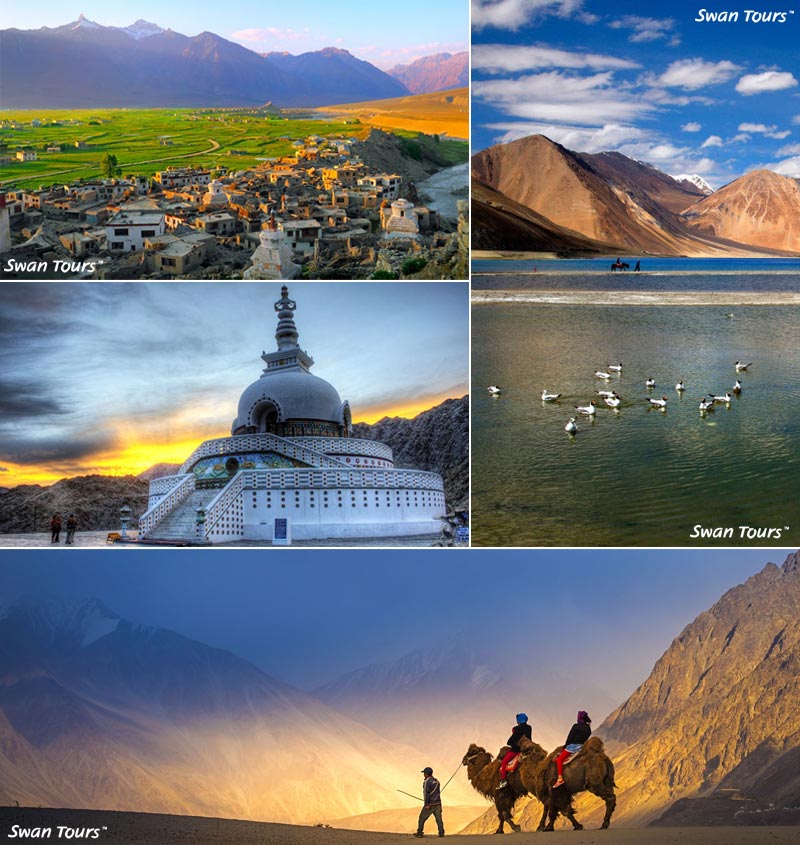Top 10 Hidden Tourist Places in Leh Ladakh
Leh Ladakh is one of the most exciting tourist destinations in India, Nubra valley and pangong Lake are already on the bucket list of the visitors to the area. Leh Ladakh Tours customized by Swan Tours also incorporates a visit to the below 10 hidden places in Leh Ladakh.
#1. Chorbad
Balti village and principality on the Shayog River adjoining Lower Ladakh and separated from it by the Chorbad pass. It was conquered in 1662 or 1674 by the Ladakhi forces under Shakya-rgya-mtsho in the reign of bDe-Idan-rnam-rgyal (c.1640-75) when also the capital Khapalu was taken.
#2. Chushod
Large village in Upper Ladakh on the southern bank of the Indus. It is predominantly a Mohamedan settlement and may have been started at the end of the sixteenth century, when due to the Balti wars Ladakh had to accept the suzerainty of the Mohamedan Baltis. It probably grew to its present size during the seventeenth century when political developments favored such an expansion.
#3. Chushul
Village in Upper Ladakh south of the Pangkong lake. In 1842 in the course of the second Dogra war Dewan Hari Chand pursuing the retreating Tibetan forces gained here, according to one account, a decisive victory.
#4. Da
Village in Lower Ladakh on the north of the Indus, inhabited by Dards. In the fifteenth century the Khri Sultans of dKhar-rtse assisted Kashmir in annexing this ‘Brog-pa i.e. Dard district of Da, till then a part of Nga-ris-skor-gsum.
#5. Daru
Village in Upper Ladakh north of the Kashmir-Leh road between Phyang and Nyemo. A rock inscription here refers to Lha-chen-bha-gan and his minister Phyag-rdor-jo. Bha-gan deposed and imprisoned the last king of the first dynasty and founded the second dynasty. He reigned from c.1470-1500.
#6. Demchog
A fortified place and ancient monastery at the Lha-ri brook, on the west bank of the Indus, after the Leh-Lhasa trade route had passed into Tibetan territory. It is mentioned as marking the border, when Ladakh was assigned to Lha-chen-dpal-gyi-mgon (c. 930-960) and again in the Treaty of Tingmogang in 1683.
#7. Desky ID
A village in Nubra, south of the confluence of the Nubra and Shayog rivers with a picturesquely situated monastery. Its name occurs in a hymn addressed to King Nyi-ma-rnam rgyal (c.1705-34).
#8. Domkhar
Village in Lower Ladakh north of the Indus one stage from Khalaste on the road to Baltistan. A rock inscription refers to King rNam-rgyal-mgon-po
#9. Dorkug
Village in Upper Ladakh west of the Pangkong lake on a southern tributary of the Shayog river. During the second Dogra war in 1842 Dewan Hari Chand defeated here a Ladakhi-Tibetan force retreating to Nubra.
#10. Drangtse
Small village and gompa in Upper Ladakh west of the Pangkong Lake on a southern tributary of the Shayog River. For centuries it was an important staging place for caravans, as here the route from Turkistan down the Shayog valley branched off either west to Leh or east to Ruthog and Garthog. It abounds with rock inscriptions among them the ye dharma formula in Gupta script of the ninth century. Of particular interest is also a Nestorian Christian inscription in Soghdian script captioned with a Greek cross stating that “Charansar from Samarkand journeying 215 stages reached Tibet.” Its age is undetermined as it bears no date but it may be of the ninth or tenth century. It is the southern-most point at which a Soghdian inscription has been found.
For more information on tours in leh ladakh contact Swan Tours, one of the leading travel agents in Connaught place New Delhi India.

